We will be undertaking a 15-day field project off Hawai‘i Island starting October 18th, 2013. We have several primary goals for this project – perhaps the most ambitious is to try deploy LIMPET satellite tags on dwarf sperm whales – something we have never tried before. This species has a reputation for being difficult to approach, but over the years we’ve encountered this species on more than 75 occasions in Hawai‘i and have learned to predict their behavior to some degree.We’ve obtained funding from the Office of Naval Research Marine Mammals and Biology Program to try to obtain movement and diving behavior data from this poorly-known species using LIMPET satellite tags. We also have funding from the Pacific Islands Fisheries Science Center to continue our work with false killer whales and pantropical spotted dolphins, and are working with Russ Andrews of the Alaska SeaLife Center and University of Alaska Fairbanks on a project involving tagging of short-finned pilot whales. We also have funding from Dolphin Quest for a small number of LIMPET satellite tags that we hope to deploy on other species (beaked whales, sperm whales, pygmy killer whales, melon-headed whales, bottlenose dolphins, or rough-toothed dolphins), to help understand their movements and habitat use. As always we will also be using photo-identification and biopsy sampling of most species to learn more about the abundance and population structure of Hawaiian odontocetes.
The research crew for this project will include Daniel Webster, Annie Douglas, Annie Gorgone, and Robin Baird, all from Cascadia, Amy Van Cise from Scripps Institution of Oceanography, Russ Andrews, and a number of volunteers.
If you want some background information on our work in Hawai‘i we published a paper on our first 13 years of surveys and a pdf is available here
November 1, 2013 update
Today was our last day on the water for this trip, and it ended on a high note. We encountered a group of four killer whales, only the third time we’ve seen this species in Hawaiian waters.
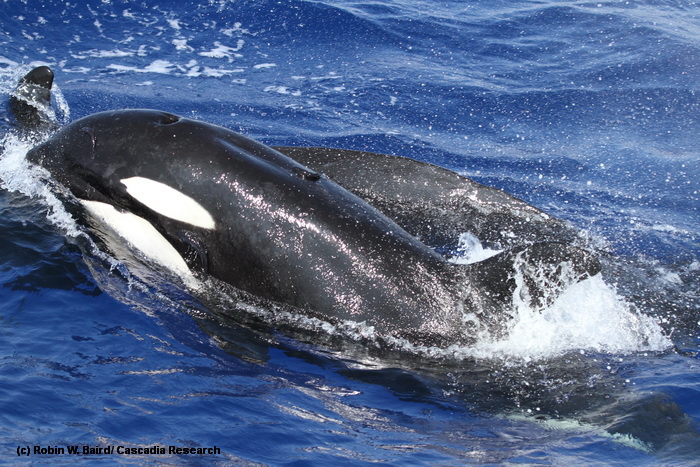
A sub-adult killer whale with several remoras on it, November 1, 2013. Photo (c) Robin W. Baird. We were able to get good identification photos of all four individuals, collected one biopsy sample for genetic studies, and deployed satellite tags on three of the four individuals. These are the first satellite tags we’ve deployed on killer whales in Hawaiian waters, and we think the first tags deployed on this species in the tropical Pacific, so are excited about learning where these whales spend their time.
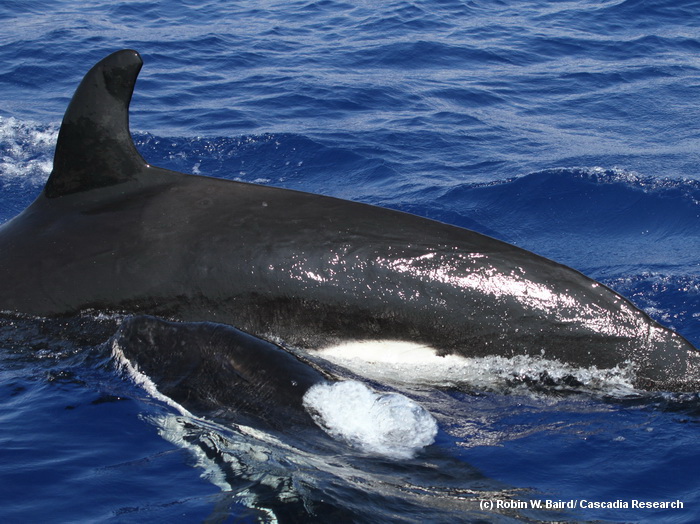
An adult female (background) and sub-adult (foregroup), photo (c) Robin W. Baird. The saddle patch of killer whales in Hawaiian waters is typically very dark, as seen in this adult female (see for more information on killer whales in Hawaii)
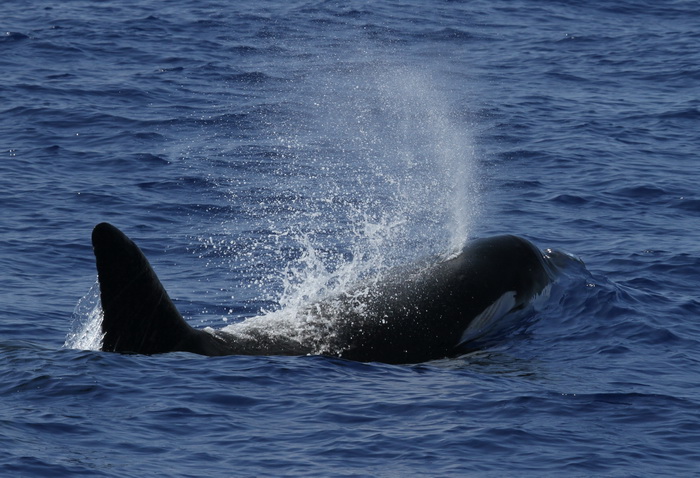
Adult male killer whale, November 1, 2013. Photo (c) Aliza Milette. Cascadia has a small photo-identification catalog of this species in Hawaiian waters, and the photos will be compared to see if any of the individuals have been previously identified here.

The two sub-adults in the group had a number of remoras on them, not unusual for tropical killer whales. Photo (c) Annie M. Gorgone.
October 31, 2013 update
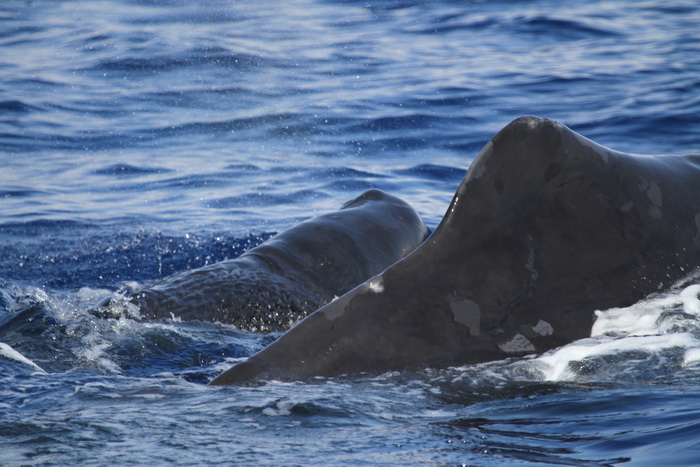
Sperm whale mother and calf, October 31, 2013. Photo (c) Annie M. Gorgone. Today we encountered our second group of sperm whales – the satellite tagged individual in the first group we encountered last week was southwest of South Point, so we suspect all of these are new individuals. We estimated 32 individuals in the group.

Tagging a sperm whale with a LIMPET satellite tag, October 31, 2013. Photo (c) Robin W. Baird. This photo was taken a fraction of a second after a LIMPET tag was deployed on this adult female-sized sperm whale. The tag is visible on the right side of the dorsal fin of the individual, and the arrow that held the tag is in the air above the whale. This is the first time we’ve had tags on two different groups of sperm whales in Hawai‘i.
October 30, 2013 update
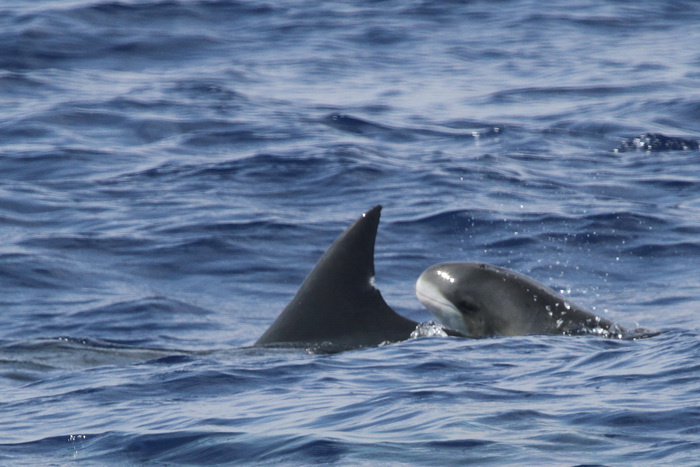
A mother and calf pygmy killer whale, October 30, 2013. Photo (c) Annie M. Gorgone. Today we encountered our 11th species of odontocete for the trip, a group of about 13 pygmy killer whales. We were able to get identification photos of every individual present, and recognized several in the field as part of “cluster 18”, one of the groups that is resident to the island. For more information on pygmy killer whales in Hawai‘i see our web page on this species
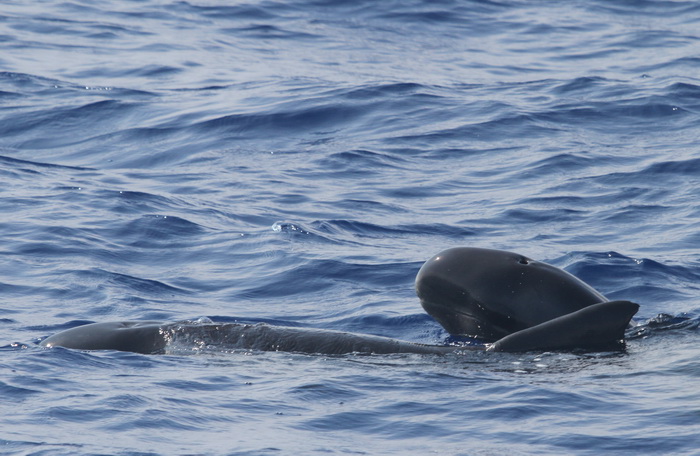
A different mother and calf pygmy killer whale, this calf a bit older than the one above. Photo (c) Ed G. Lyman. We also encountered a group of short-finned pilot whales.
October 28, 2013 update

Today we encountered our 10th species of odontocete for the trip, a large dispersed group of rough-toothed dolphins. Photo (c) Annie B. Douglas. We also had two encounters with Cuvier’s beaked whales, including two mother-calf pairs, and were able to get identification photos of several individuals.

A rough-toothed dolphin leaping – the white scars on the belly are caused by cookie-cutter sharks. Photo (c) Russ D. Andrews
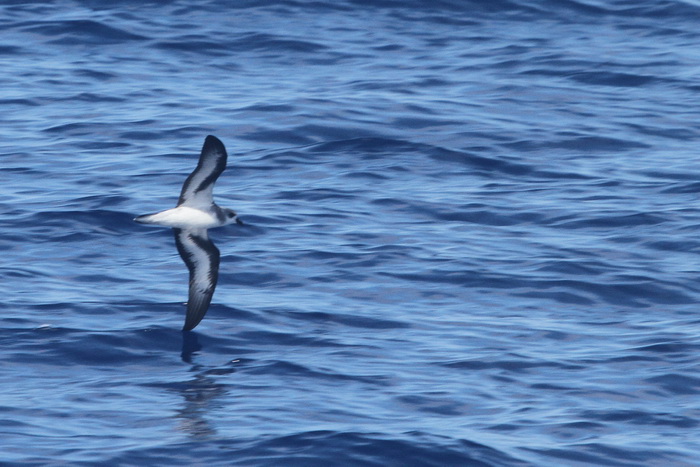
A Black-winged Petrel, October 28, 2013. Photo (c) Amy Van Cise. For more information on seabirds in Hawaii see our seabird page
October 27, 2013 update
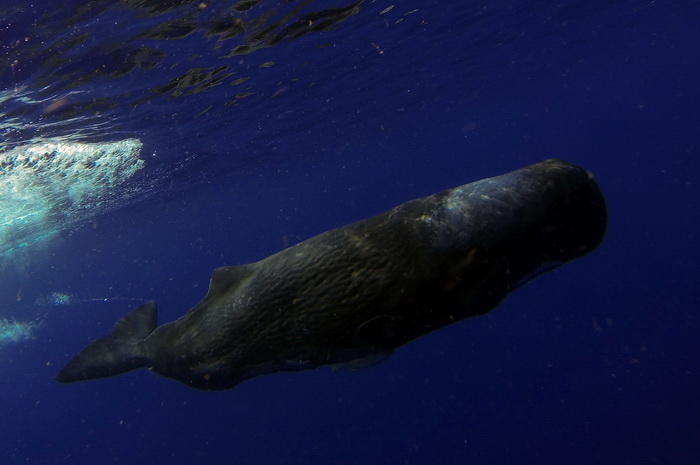
A sperm whale, taken from a GoPro on a pole over the side of the boat. Photo (c) James Begeman. Today we encountered our 9th species of odontocete for the trip, a group of about 20 sperm whales. Sperm whales are typically found in very deep water in Hawai‘i, and as far as we know are not resident to the islands, but instead roam over a broad range.
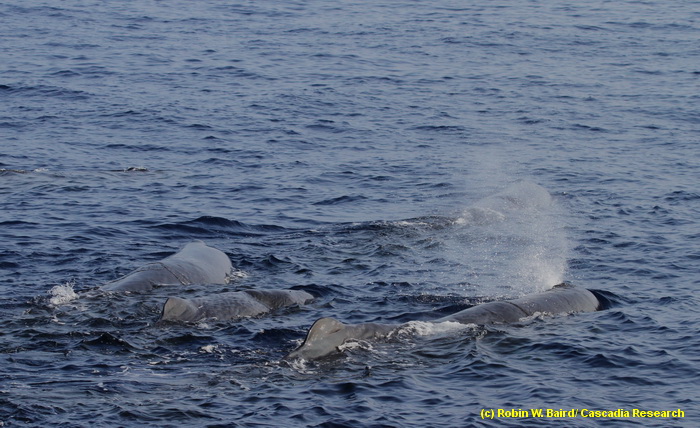
The group we saw today was composed of females, juveniles and calves – adult males are only rarely seen in Hawaiian waters. Photo (c) Robin W. Baird. We satellite tagged one individual, and also collected one biopsy for genetic studies. Sperm whales in Hawai‘i rarely fluke, so we mainly try to identify individuals based on dorsal fin photos.
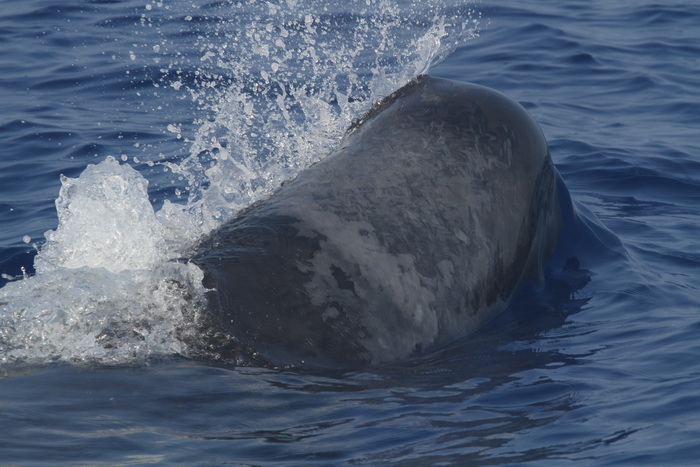
Close up of the head of a juvenile sperm whale, photo (c) Annie M. Gorgone.
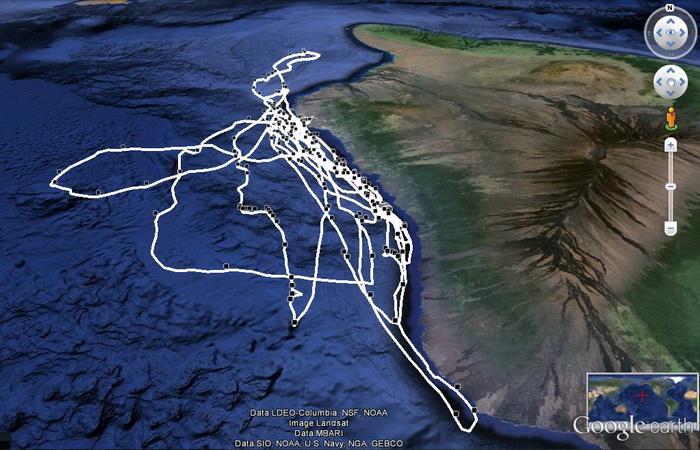
Our tracklines for the project so far.
October 25, 2013 update

Today we rescued another Hawaiian Petrel in distress, and encountered a group of about 20 short-finned pilot whales. Photo (c) Robin W. Baird. We were able to photograph all the individuals present, and deployed a satellite tag to track the movements of this group.

A short-finned pilot whale calf with remoras, October 25, 2013. Photo (c) Annie M. Gorgone.
Speaking of satellite tags, we are getting good data from all the 9 previous tags deployed this trip (3 pilot whales, 1 bottlenose dolphin, 1 Blainville’s beaked whale, and 4 false killer whales, 1 from the insular population and 3 from the pelagic population). Maps of false killer whale movements from the last 4-5 days are below.

Map showing the movements of the insular false killer whale since we tagged it on Monday.
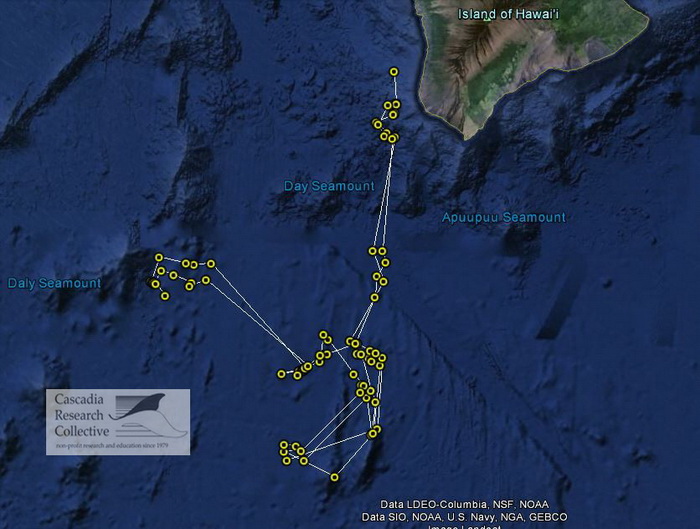
Map showing the movements of two of the three pelagic false killer whales since we tagged them on Tuesday. In the two days after tagging the individuals moved ~185 kilometers south of the island, and have since been skirting the edges of several seamounts.
October 23, 2013 update
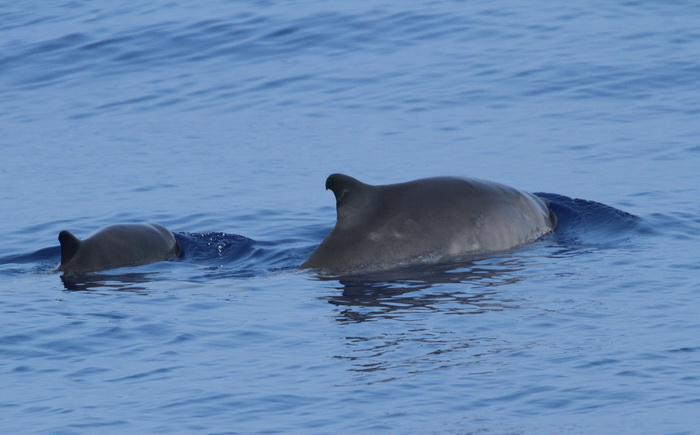
A mother/calf pair of dwarf sperm whale, October 23, 2013. Photo (c) Annie M. Gorgone. Today we had a very nice encounter with a group of dwarf sperm whales – there were four individuals present, two mother-calf pairs, and we were able to track the group for over an hour, and photo-identify all the individuals.
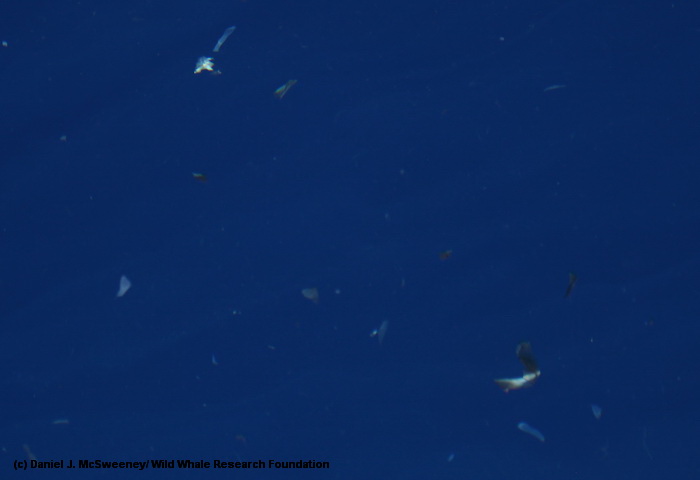
Sloughed skin in the water from dwarf sperm whales, October 23, 2013. Photo (c) Dan J. McSweeney. At one point one of the mother/calf pairs must have been rubbing together, as in their “fluke prints” we observed a cloud of bits of skin, probably several thousand bits – we were able to collect a vial full of the skin, for genetic studies of this species.

Wedge-tailed shearwater consuming some unidentified item, October 23, 2013. Photo (c) Dan J. McSweeney.
October 22, 2013 update
Another good day on the water. The false killer whale we tagged October 21st had moved north, so we started to the north to try to catch up to the group. We encountered a group of bottlenose dolphins and were able to deploy one satellite tag to track their movements – While working to the north we had a call from another boat on the water about a different group of false killer whales, so we intercepted that group.
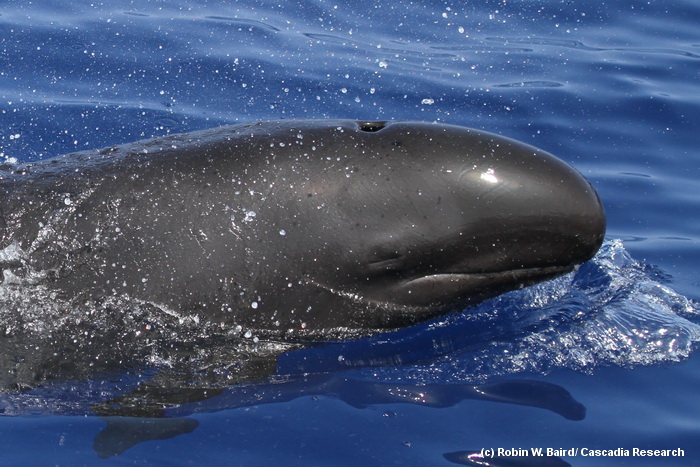
False killer whale, October 22, 2013. Photo (c) Robin W. Baird. We first encountered the group in 3,300 m of water heading rapidly south, and stayed with the group for about three and a half hours. When we encounter false killer whales, as we get good photos of individuals we compare them to our catalog in the field, to determine what group or population it is from, whether we need to collect biopsy samples, and determine how many tags to deploy. All the individuals we matched in the field were not in our catalog, suggesting this group is not part of the insular population.
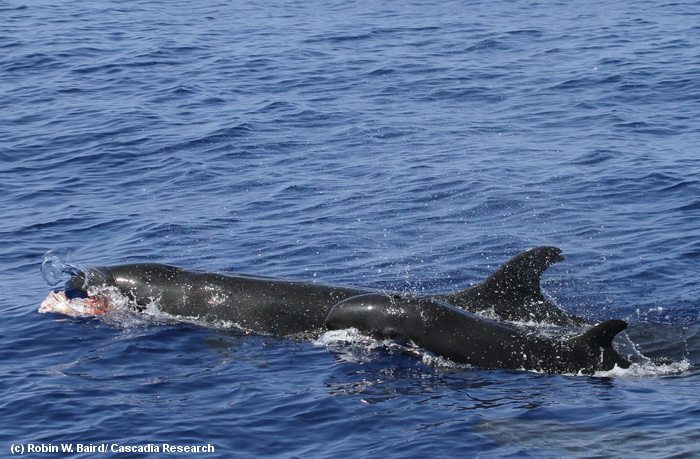
False killer whale mother and calf – the adult female has an Opah in the mouth, October 22, 2013. During the encounter we witnessed three predation events, two of which were on Opah – this is the first time we’ve seen false killer whales feeding on Opah. Photo (c) Robin W. Baird
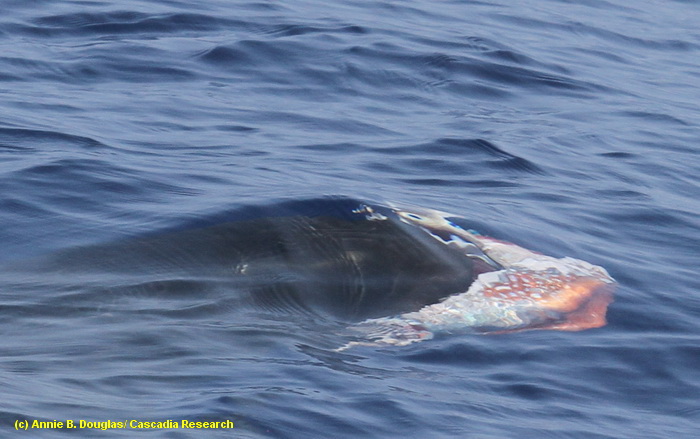
False killer whale with Opah in the mouth, Photo (c) Annie B. Douglas. Based on the lack of matches of photos we believe this group may be from the pelagic population – we obtained 6 biopsy samples, so will be able to confirm from the genetics, and also deployed three satellite tags – as of 10:30 AM today the group was 122 km south of South Point, Hawaii Island. We’ve previously encountered pelagic false killer whales off Kona on several occasions (the last in 2008), and had only satellite tagged one individual (with a short duration track), so are excited about what we might learn about this poorly known population over the next few weeks/months as data come in from the tags.
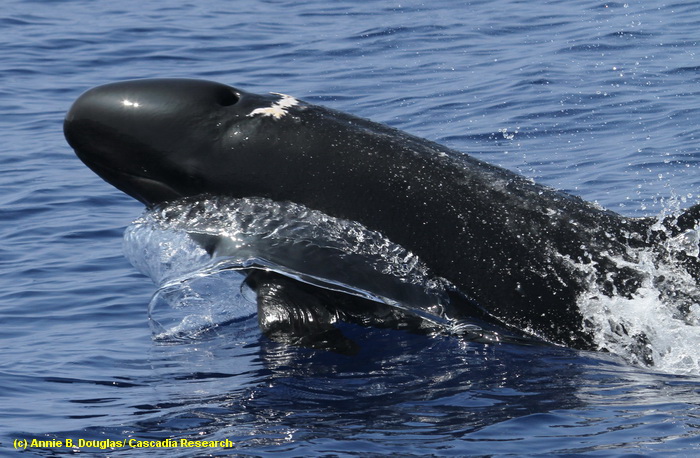
False killer whale with a scar from a wound on the head, October 22, 2013. photo (c) Annie B. Douglas.
October 21, 2013 update
One of the best parts of working off Kona is the high species diversity, and today we had five encounters of five different species of odontocetes, including four new ones for the trip, bringing the species total to eight species in our first four days.

A mother and calf pair of Cuvier’s beaked whales breaching. Photo (c) Annie B. Douglas. Our first sighting of the day, after having covered 115 km, was a group of three Cuvier’s beaked whales, all of which we were able to photo-identify.
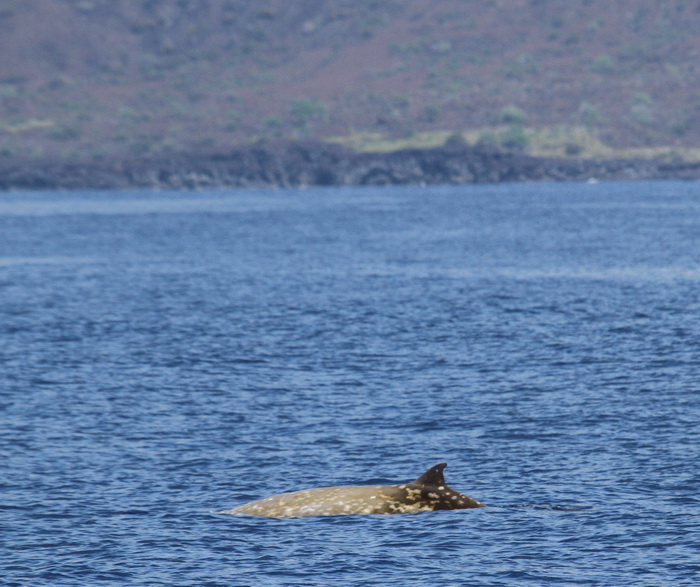
An adult Cuvier’s beaked whale off the Kona coast, October 21, 2013. Photo (c) Amy Van Cise. This group was in relatively shallow water for this species in Hawaiian waters, in about 1,000 m depth when first seen.
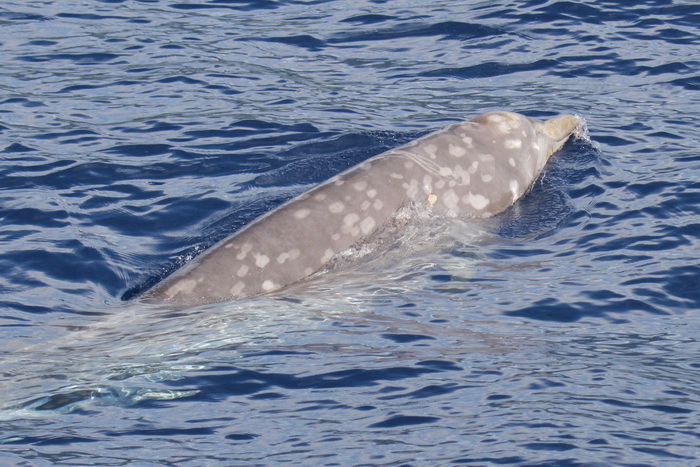
Our second sighting of the day was another species of beaked whale, this time a pair of Blainville’s beaked whales. This photo, an adult female, shows the extensive cookie-cutter scars typical of beaked whales in Hawai‘i. Photo (c) Shell S. Eisenberg. We were able to photo-identify both individuals and also deployed one depth-transmitting satellite tag on one individual.
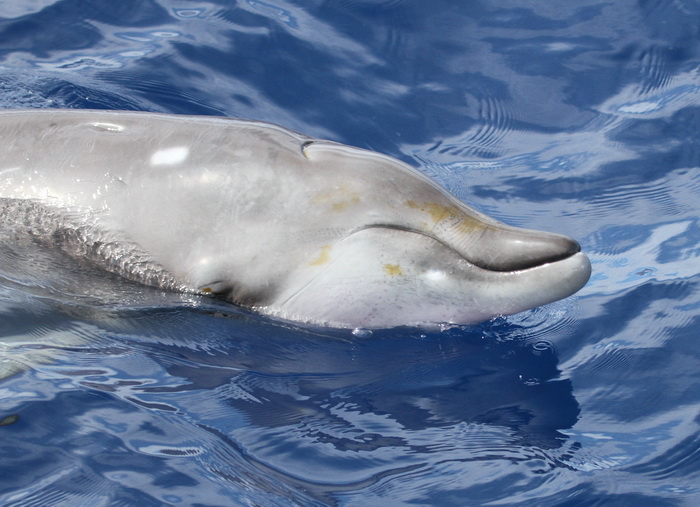
Close up of the head of a juvenile Blainville’s beaked whale. Photo (c) Amy Van Cise
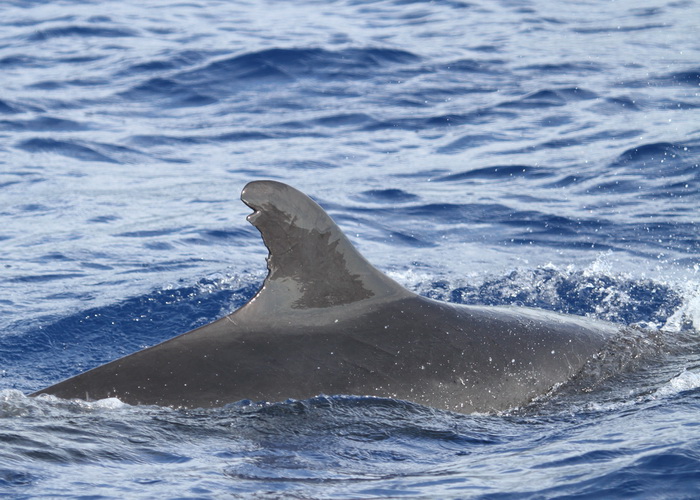
Our third sighting of the day was a group of about six false killer whales – we recognized several individuals, part of the Endangered main Hawaiian Islands insular population. We were able to photo-identify four of the individuals and deployed a satellite tag on one – we are hoping to track this group over the next few weeks/months. Photo (c) Annie M. Gorgone
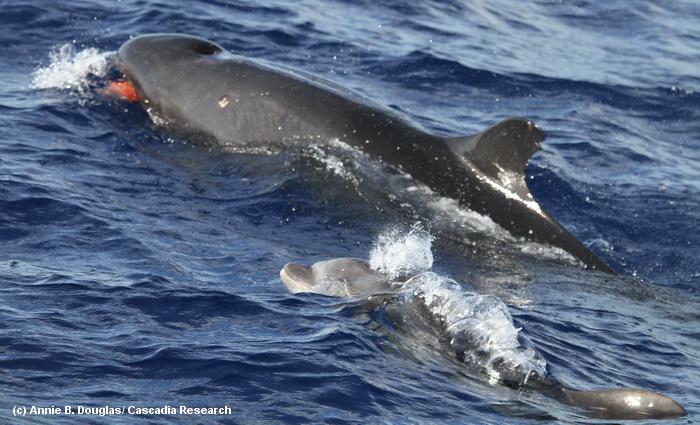
We did see the false killer whales catch one large fish, and shortly after catching the fish they were joined by a group of bottlenose dolphins (the animal in the foreground), several of which appeared to be following the false killer whales hoping to pick up scraps. Photo (c) Annie B. Douglas
October 20, 2013 update
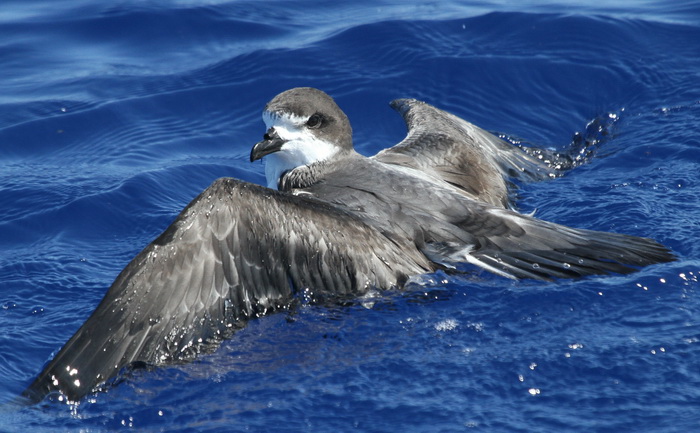
An Endangered Hawaiian Petrel in distress – we found this bird swimming at the surface, waterlogged and unable to fly – after several phone calls to local wildlife rehabilitators we captured the bird and delivered it to the Hawai‘i Wildlife Center for rehabilitation. The petrel was emaciated and weak, but we are hoping it will make a full recovery and can be released back to the wild. Photo (c) Amy Van Cise

A mother and calf pantropical spotted dolphin, October 20, 2013. Photo (c) Annie B. Douglas. As well as the Hawaiian Petrel rescue, we also encountered a group of pantropical spotted dolphins, another lone dwarf sperm whale (our third sighting in three days), and a group of short-finned pilot whales, and were able to deploy a satellite tag on the pilot whales to track the movements of this group.
October 19, 2013 update
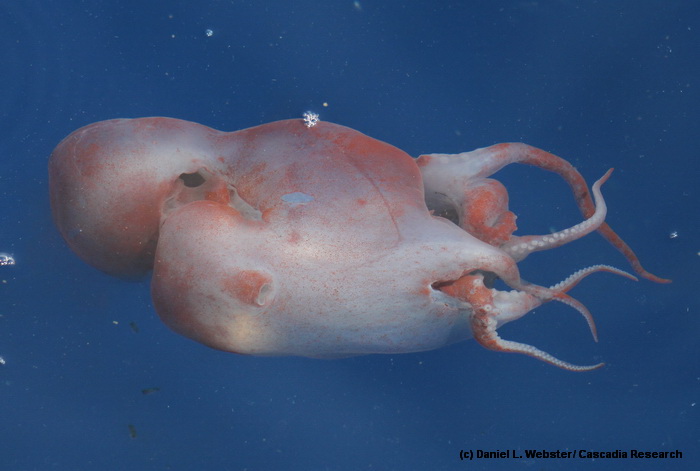
A pelagic octopus, October 19, 2013, photo (c) Daniel L. Webster. We found and collected a freshly-dead pelagic octopus, possibly of the genus Haliphron – the specimen will be sent to the National Marine Mammal Laboratory for identification and archiving for genetics and stable isotopes. This individual had just “inked” and had a bite wound, probably brought up to the surface by a beaked whale or dwarf sperm whale – if you are interested in more information on our collection of squid see a poster we presented at the Pacific Seabird Group meeting earlier this year
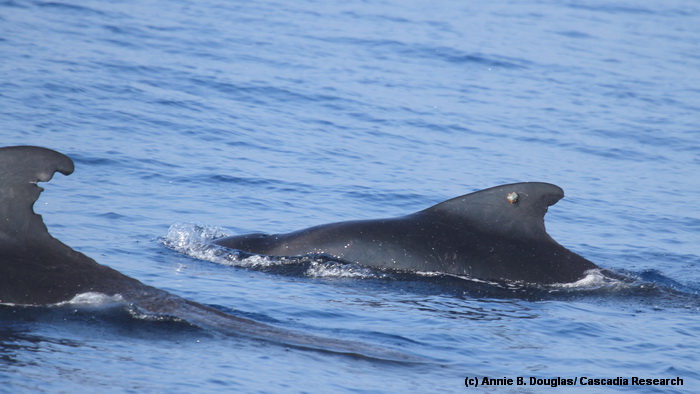
We found several groups of pilot whales today, and deployed a second satellite tag on one individual to track movements, the tag is visible on the dorsal fin of the individual on the right. Photo October 19, 2013 (c) Annie B. Douglas. The individual on left of this photo is an adult male.
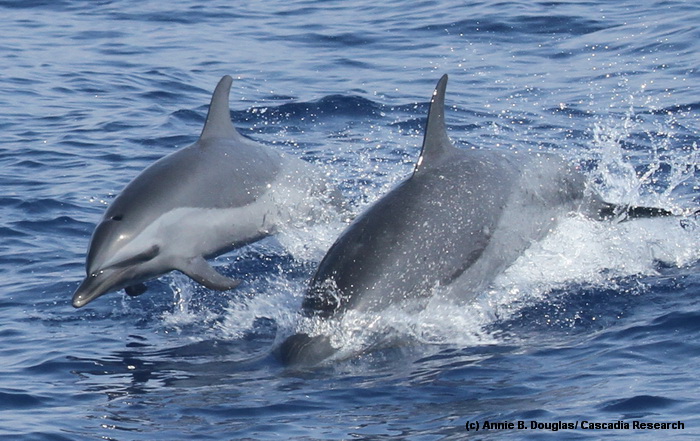
We also encountered our first group of pantropical spotted dolphins of the trip and were able to photo-identify most of the individuals present. Photo October 19, 2013, (c) Annie B. Douglas
October 18, 2013 update

A good start to the project, today we had two encounters with dwarf sperm whales (both lone individuals), and were able to get good photos of both individuals. One was well-marked and we should be able to determine whether the individual has been previously documented off the island, while the other (above) was relatively un-marked. Photo (c) Annie B. Douglas. Just as we approached the first individual we found a squid tentacle in the water, probably recently dropped by the whale.
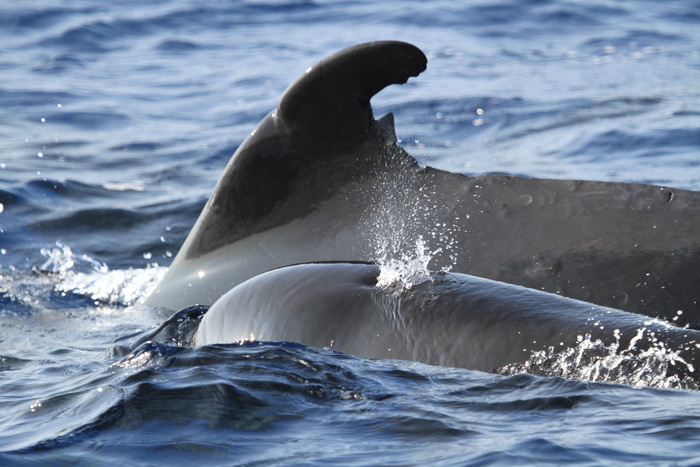
We also encountered a group of about 48 pilot whales, were able to deploy a satellite tag on one individual to track movements of the group, and photo-identified many of the individuals present. Photo (c) Annie M. Gorgone. To end the day, we recovered the “HARP” (High-frequency Acoustic Recording Package) deployed off the island earlier this year – the HARP monitors the vocal activity of cetaceans off the Kona coast, as part of a research project being undertaken by Erin Oleson of the Pacific Islands Fisheries Science Center.
Some photos from previous projects below.
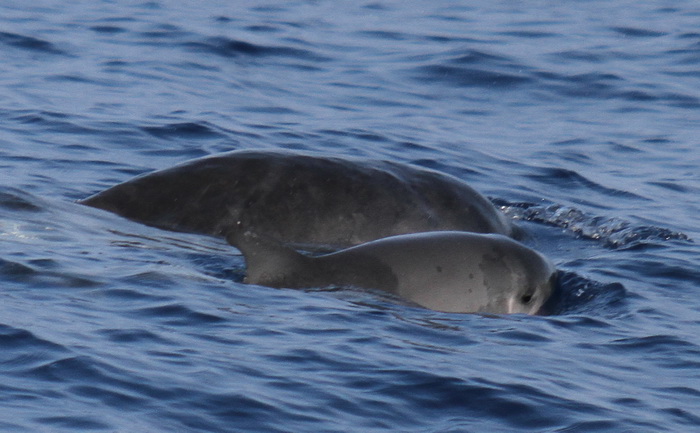
Mother and calf pair of dwarf sperm whales off Kona, October 25, 2011. Photo (c) Robin Baird
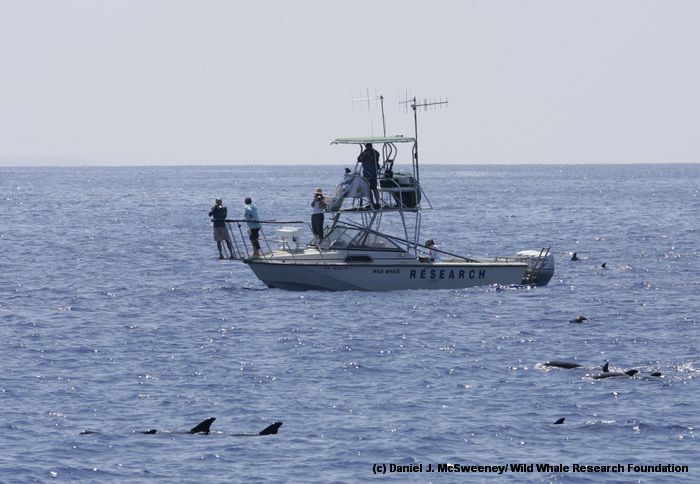
The R/V Wild Whale, a 27′ Boston Whaler, our primary research vessel, with a group of melon-headed whales off Kona, October 19, 2011. Photo (c) Dan McSweeney.
All photos are copyrighted and should not be used without permission (contact Robin Baird at rwbaird (at) cascadiaresearch.org for permission).
Like us on Facebook page if you want to receive notices of when information is posted and updates on other Cascadia projects.